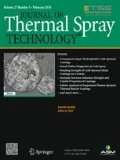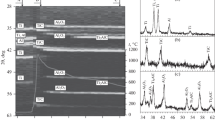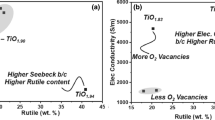Abstract
In this article, an attempt has been made to relate the thermoelectric properties of thermal spray deposits of sub-stoichiometric titania to process-induced phase and microstructural variances. The TiO2−x deposits were formed through the in situ reaction of the TiO1.9 or TiO1.7 feedstock within the high-temperature plasma flame and manipulated via varying the amounts of hydrogen fed into in the thermal plasma. Changes in the flow rates of H2 in the plasma plume greatly affected the in-flight particle behavior and composition of the deposits. For reference, a high-velocity oxy-fuel spray torch was also used to deposit the two varieties of feedstocks. Refinements to the representation of the in-flight particle characteristics derived via single particle and ensemble diagnostic methods are proposed using the group parameters (melting index and kinetic energy). The results show that depending on the value of the melting index, there is an inverse proportional relationship between electrical conductivity and Seebeck coefficient, whereas thermal conductivity has a directly proportional relationship with the electrical conductivity. Retention of the original phase and reduced decomposition is beneficial to retain the high Seebeck coefficient or the high electrical conductivity in the TiO2 system.











Similar content being viewed by others
References
H. Scherrer, S. Scherrer, and D. Rowe, Section V Thermoelectric Systems and Applications, Thermoelectric Handbook—Macro to Nano, D.M. Rowe, Ed., Taylor & Francis, 2006
G.J. Snyder and E.S. Toberer, Complex Thermoelectric Materials, Nat. Mater., 2008, 7(2), p 105-114
Y. Pei, J. Lensch-Falk, E.S. Toberer, D.L. Medlin, and G.J. Snyder, High Thermoelectric Performance in PbTe Due to Large Nanoscale Ag2Te Precipitates and La Doping, Adv. Funct. Mater., 2011, 21(2), p 241-249
M. Zhou, J.-F. Li, and T. Kita, Nanostructured AgPbmSbTem+2 System Bulk Materials with Enhanced Thermoelectric Performance, J. Am. Chem. Soc., 2008, 130(13), p 4527-4532
S.H. Yang, T.J. Zhu, T. Sun, J. He, S.N. Zhang, and X.B. Zhao, Nanostructures in High-Performance (GeTe)×(AgSbTe2)100−x thermoelectric materials, Nanotechnology, 2008, 19(24), p 245707
H. Lee, R.C. Seshadri, S.J. Han, and S. Sampath, TiO2−X Based Thermoelectric Generators Enabled by Additive and Layered Manufacturing, Appl. Energy, 2017, 192, p 24-32
C. Wood, Materials for Thermoelectric Energy-Conversion, Rep. Prog. Phys., 1988, 51(4), p 459-539
S. Walia, S. Balendhran, H. Nili, S. Zhuiykov, G. Rosengarten, Q.H. Wang, M. Bhaskaran, S. Sriram, M.S. Strano, and K. Kalantar-zadeh, Transition Metal Oxides-Thermoelectric Properties, Prog. Mater. Sci., 2013, 58(8), p 1443-1489
H. Lee, S.J. Han, R. Chidambaram Seshadri, and S. Sampath, Thermoelectric Properties of In Situ Plasma Spray Synthesized Sub-Stoichiometry TiO2−x, Sci. Rep., 2016, 6, p 36581
H. Herman, Plasma-Sprayed Coatings, Sci. Am., 1988, 259(3), p 112-117 (in English)
P. Fauchais, A. Vardelle, and B. Dussoubs, Quo Vadis Thermal Spraying?, J. Therm. Spray Technol., 2001, 10(1), p 44-66
P. Fauchais, M. Fukumoto, A. Vardelle, and M. Vardelle, Knowledge Concerning Splat Formation: An Invited Review, J. Therm. Spray Technol., 2004, 13(3), p 337-360
D. Apelian, M. Paliwal, R.W. Smith, and W.F. Schilling, Melting and Solidification in Plasma Spray Deposition—Phenomenological Review, Int. Met. Rev., 2013, 28(1), p 271-294
S. Sampath and H. Herman, Rapid Solidification and Microstructure Development During Plasma Spray Deposition, J. Therm. Spray Technol., 1996, 5(4), p 445-456
L.M. Sun, C.C. Berndt, and C.P. Grey, Phase, Structural and Microstructural Investigations of Plasma Sprayed Hydroxyapatite Coatings, Mater. Sci. Eng. A Struct., 2003, 360(1–2), p 70-84
Z. Wang, A. Kulkarni, S. Deshpande, T. Nakamura, and H. Herman, Effects of Pores and Interfaces on Effective Properties of Plasma Sprayed Zirconia Coatings, Acta Mater., 2003, 51(18), p 5319-5334
W. Chi, S. Sampath, and H. Wang, Microstructure-Thermal Conductivity Relationships for Plasma-Sprayed Yttria-Stabilized Zirconia Coatings, J. Am. Ceram. Soc., 2008, 91(8), p 2636-2645
A. Sharma, A. Gouldstone, S. Sampath, and R.J. Gambino, Anisotropic Electrical Conduction from Heterogeneous Oxidation States in Plasma Sprayed TiO2 Coatings, J. Appl. Phys., 2006, 100(11), p 114906
J.R. Colmenares-Angulo, V. Cannillo, L. Lusvarghi, A. Sola, and S. Sampath, Role of Process Type and Process Conditions on Phase Content and Physical Properties of Thermal Sprayed TiO2 Coatings, J. Mater. Sci., 2009, 44(9), p 2276-2287
J.F. Bisson, C. Moreau, M. Dorfman, C. Dambra, and J. Mallon, Influence of Hydrogen on the Microstructure of Plasma-Sprayed Yttria-Stabilized Zirconia Coatings, J. Therm. Spray Technol., 2005, 14(1), p 85-90
A. Vaidya, G. Bancke, S. Sampath, and H. Herman, Influence of Process Variables on the Plasma-sprayed Coatings: An Integrated Study, Thermal Spray 2001: New Surfaces for a New Millennium, Proceedings of the International Thermal Spray Conference, C.C. Berndt, K.A. Khor, and E.F. Lugscheider, Eds., May 28–30, 2001 (Singapore), ASM International, Materials Park, OH, 2001, p 1345-1349
S. Sampath, X. Jiang, A. Kulkarni, J. Matejicek, D.L. Gilmore, and R.A. Neiser, Development of Process Maps for Plasma Spray: Case Study for Molybdenum, Mater. Sci. Eng. A Struct., 2003, 348(1–2), p 54-66
V. Srinivasan, M. Friis, A. Vaidya, T. Streibl, and S. Sampath, Particle Injection in Direct Current Air Plasma Spray: Salient Observations and Optimization Strategies, Plasma Chem. Plasma Process., 2007, 27(5), p 609-623
P. Scardi and M. Leoni, Whole Powder Pattern Modelling, Acta Crystallogr. A, 2002, 58(Pt 2), p 190-200
R.W. Cheary and A. Coelho, A Fundamental Parameters Approach to X-ray Line-Profile Fitting, J. Appl. Crystallogr., 1992, 25(2), p 109-121
S.J. Han, Y. Chen, and S. Sampath, Role of Process Conditions on the Microstructure, Stoichiometry and Functional Performance of Atmospheric Plasma Sprayed La (Sr) MnO3 Coatings, J. Power Sources, 2014, 259, p 245-254
T. Streibl, A. Vaidya, M. Friis, V. Srinivasan, and S. Sampath, A Critical Assessment of Particle Temperature Distributions During Plasma Spraying: Experimental Results for YSZ, Plasma Chem. Plasma Process., 2006, 26(1), p 73-102
R.S. Lima and B.R. Marple, Near-Isotropic Air Plasma Sprayed Titania, Acta Mater., 2004, 52(5), p 1163-1170
I.C. Madsen, N.V.Y. Scarlett, L.M.D. Cranswick, and T. Lwin, Outcomes of the International Union of Crystallography Commission on Powder Diffraction Round Robin on Quantitative Phase Analysis: Samples 1a to 1h, J. Appl. Crystallogr., 2001, 34(4), p 409-426
I.E. Grey, C. Li, and I.C. Madsen, Phase-Equilibria and Structural Studies on the Solid-Solution MgTi2O5-Ti3O5, J. Solid State Chem., 1994, 113(1), p 62-73
P. Ctibor, R.C. Seshadri, J. Henych, V. Nehasil, Z. Pala, and J. Kotlan, Photocatalytic and Electrochemical Properties of Single- and Multi-layer Sub-stoichiometric Titanium Oxide Coatings Prepared by Atmospheric Plasma Spraying, J. Adv. Ceram., 2016, 5(2), p 126-136
J.F. Banfield, D.R. Veblen, and D.J. Smith, The Identification of Naturally Occurring TiO2 (B) by Structure Determination Using High-Resolution Electron Microscopy, Image Simulation, and Distance-Least-Squares Refinement, Am. Miner., 1991, 76(3–4), p 343-353
A.D. Jadhav, N.P. Padture, E.H. Jordan, M. Gell, P. Miranzo, and E.R. Fuller, Low-Thermal-Conductivity Plasma-Sprayed Thermal Barrier Coatings with Engineered Microstructures, Acta Mater., 2006, 54(12), p 3343-3349
M. Pasandideh-Fard, V. Pershin, S. Chandra, and J. Mostaghimi, Splat Shapes in a Thermal Spray Coating Process: Simulations and Experiments, J. Therm. Spray Technol., 2002, 11(2), p 206-217
H. Zhang, H.B. Xiong, L.L. Zheng, A. Vaidya, L. Li and S. Sampath, Melting Behavior of In-flight Particles and its Effects on Splat Morphology in Plasma Spraying, 2002 ASME International Mechanical Engineering Congress and Exposition, November 17–22, American Society of Mechanical Engineers, New Orleans, LA, 2002
Y. He, Y. Jin, H. Chen, Y. Ding, D. Cang, and H. Lu, Heat Transfer and Flow Behaviour of Aqueous Suspensions of TiO2 Nanoparticles (Nanofluids) Flowing Upward Through a Vertical Pipe, Int. J. Heat Mass Transf., 2007, 50(11), p 2272-2281
Y. Li and T. Ishigaki, Thermodynamic Analysis of Nucleation of Anatase and Rutile from TiO2 Melt, J. Cryst. Growth, 2002, 242(3), p 511-516
A. Singh, Thermal Conductivity of Nanofluids, Def. Sci. J., 2008, 58(5), p 600
Acknowledgments
This work was supported by the National Science Foundation Partnership for Innovation (NSF-PFI) Program under Award Number IIP-1114205. The US-Czech collaboration included in this paper was funded in part by the NSF—International collaboration supplement. Zdenek Pala has been financially supported by the AdMat project of the Czech Science Foundation (14-36566G). Support through the Stony Brook Industrial Consortium for Thermal Spray Technology is also acknowledged. This research used resources of the Center for Functional Nanomaterials, which is a US DOE Office of Science Facility, at Brookhaven National Laboratory, under Contract No. DE-SC0012704.
Author information
Authors and Affiliations
Corresponding author
Appendix
Appendix
The earlier work by Vaidya et al. (Ref 21) has shown that the melting state of ceramic particles can be described through group parameter referred to as melting index. This is expressed as:
where Ts is the measured particle surface temperature (K), Δtfly is the particle in-flight time assuming the constant acceleration of particles (s), and D is the particle size (m), which has the following expression:
where L is the spray distance (m) and v is the particle velocity (m s−1). More comprehensive formulations have been derived by Zhang et al. (Ref 35) redefined as
where ΔTmelt is the total melting time (s), Tm is particle melting temperature (K), A is dimensionless factor, h is heat transfer coefficient (W m−2 k−1), ρ is particle density (kg m−3), hfg is enthalpy of fusion (kJ kg−1), Bi is Biot number, Tf is flame temperature (K), and kl is thermal conductivity of liquid material (W m−1 k−1), respectively.
Another group parameter Reynolds number refers to
where µ is dynamic viscosity (Ns m−2 or kg m−1 s−1) and υ is kinematic viscosity (m2 s−1). In this paper, the assumption was made for Tf = Ts since flame temperature around particles is not constant during the time of flight and it is not possible to measure it accurately. For TiO1.9 and TiO1.7 feedstock, the density and particle melting index were measured to be 3.973 and 3.917 kg m−3, and 1942 and 1868 K, respectively. The heat transfer coefficient h was assumed constant for all calculations. Thermophysical properties used in the calculations are summarized in Table 3.
Rights and permissions
About this article
Cite this article
Lee, H., Seshadri, R.C., Pala, Z. et al. Optimizing Thermoelectric Properties of In Situ Plasma-Spray-Synthesized Sub-stoichiometric TiO2−x Deposits. J Therm Spray Tech 27, 968–982 (2018). https://doi.org/10.1007/s11666-018-0731-1
Received:
Revised:
Published:
Issue Date:
DOI: https://doi.org/10.1007/s11666-018-0731-1




